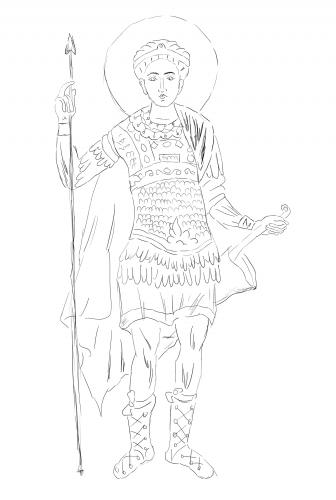



Saint Demetrius of Thessaloniki, the Great Martyr
Because there are two hagiographies connected with St. Demetrius of Thessaloniki, one assigning him a high position in the Roman administration, the other a military career, the iconographic canon depicting him has never reached the level of standardization common to other canonical themes. During the Byzantine period St. Demetrius is sometimes depicted in aulic vestments, as in the Thessaloniki chapel which hosts his relics. But, as the hagiographic legend concentrates more on the military career variant, the military attire is preferable. Thus, St. Demetrius is represented either standing or bust, sometimes riding a horse - in those images which are borrowing iconographic traces from St. George's canon. However, in St. Demetrius' case, the dragon is replaced by a pagan gladiator, responsible for killing many Christians. He is clad like a Roman officer of the Late Antiquity: a short tunic above the knees, a coat of mail - rarely a breastplate, a balteus and military high boots. St. Demetrius may wear different weapons, the sword being frequent, but quite often this is replaced by a spear, the weapon of his martyrdom but also that with which he killed the pagan. He may also wear a cross or a palm branch in his hand, both symbols of martyrdom in faith. As far as the physical aspect is concerned, St. Demetrius is depicted as a young, beardless man with a harmonious face and short wavy hair.
Because there are two hagiographies connected with St. Demetrius of Thessaloniki, one assigning him a high position in the Roman administration, the other a military career, the iconographic canon depicting him has never reached the level of standardization common to other canonical themes. During the Byzantine period St. Demetrius is sometimes depicted in aulic vestments, as in the Thessaloniki chapel which hosts his relics. But, as the hagiographic legend concentrates more on the military career variant, the military attire is preferable. Thus, St. Demetrius is represented either standing or bust, sometimes riding a horse - in those images which are borrowing iconographic traces from St. George's canon. However, in St. Demetrius' case, the dragon is replaced by a pagan gladiator, responsible for killing many Christians. He is clad like a Roman officer of the Late Antiquity: a short tunic above the knees, a coat of mail - rarely a breastplate, a balteus and military high boots. St. Demetrius may wear different weapons, the sword being frequent, but quite often this is replaced by a spear, the weapon of his martyrdom but also that with which he killed the pagan. He may also wear a cross or a palm branch in his hand, both symbols of martyrdom in faith. As far as the physical aspect is concerned, St. Demetrius is depicted as a young, beardless man with a harmonious face and short wavy hair.




